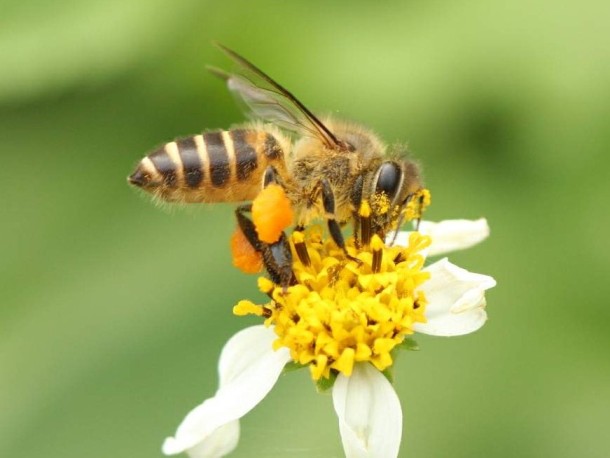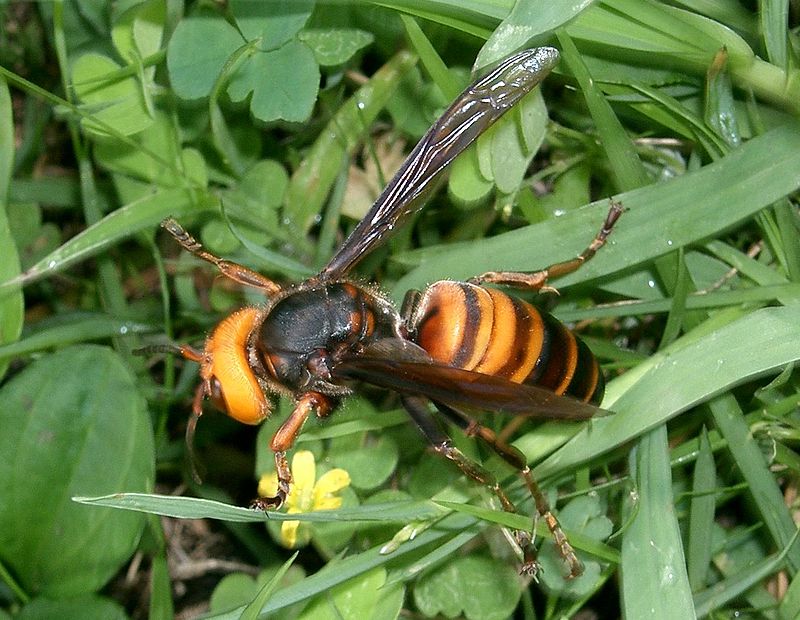Fun Fact: Did You Know Japanese Honeys Bees Engulf Giant Hornets Into A Ball And Literally Heat Them To Death?!

Apis cerana worker bee (CC BY-SA 3.0, Credit)
So, today I came into one of those rare strange animal facts that really make my mind blow. Naturally, sharing it with you guys was one of my first reactions!
First, allow me to give you a short introduction to the Japanese honey bee before jumping to the main dish. Also known as the "Asiatic honey bee", the Japanese honey bee (Apis cerana japonica) is a subspecies of the Eastern honey bee native to Japan.
For years now, beekeepers in Japan have tried to introduce the european honey bee (Apis mellifera), which is the most common species of domesticated bee. The reason they do that is because A. mellifera is a more domesticated,easier to handle species and also produces a much higher yield. However, this can be often...problematic. Why?
That's why:
 Japanese Giant Hornet ( CC BY-SA 3.0, credit)
Japanese Giant Hornet ( CC BY-SA 3.0, credit)
Meet the Japanese Giant Hornet, a subspecies of the world's largest hornet (Vespa mandarinia). Compared to bees they are true giants, with adults often growing to almost 5 cm, about 5 times larger than the bees!
If you are a bee, this could well be the last thing you see in your life as the hornets actively predate on them. And it's not a beautiful death. As you will soon see it's often a death by dismemberment, as they cut the head and legs, or for the 'lucky" ones a slow & painful death during which they witness their fellow warriors and young die one by one... Just one hornet is more than enough to take head on and kill hundreds of poor bees in mere minutes.
When predating, they typically send a few scouters to locate bee hives to attack and when one is located the scouter leaves a special pheromone that soon attracts its buddies. After that, it's massacre time!
Just have a look at this video, 30 of those hornets are more than enough to fully eradicate a colony, killing approximately 30.000 bees in a single attack:
But unlike their European cousins, the Japanese honey bees have come up with a genius defensive mechanism to get back to those nasty predators. A mechanism, proof that sometimes true strength lies in co-operation. Instead of attacking the scooter the bees initially retreat, giving it more space to move and essentially luring it to a trap that it has no idea is coming.
The scooter takes a few more steps inside the nest and then, out of the blue, it happens. In an instant, the intruder finds itself TOTALLY covered in a ball of death. A ball created by hundreds of bees, as they surround its body with their bodies. A ball of death that essentially acts as an oven, as the bees vibrate their wings the same way they do when heating the nest in times of cold, gradually increasing the temperature in the ball until the critical point of 46 °C.
This temperature is more than enough to kill the hornets but not enough to kill the bees. Sure, some fall in the battlefield by the bites of the hornet, but with the scooter dead the nest gets to live another day.
Initially, it was believed that this increase in temperature was enough to kill the invader. But recent research has shown that hornets can survive for 10 min at the temperature up to 47°C, whereas the temperature inside the bee balls does not rise higher than 45.9°C. So why do the hornets die? The answer lies in CO2 concentration, which also increases inside the ball, thanks to the exertions of the bees:
"In controlled experiments, hornets can survive for 10 min at the temperature up to 47°C, whereas the temperature inside the bee balls does not rise higher than 45.9°C. We have found here that the CO2 concentration inside the bee ball also reaches a maximum (3.6 ± 0.2%) in the initial 0–5 min phase after bee ball formation.
The lethal temperature of the hornet (45–46°C) under conditions of CO2 concentration (3.7 ± 0.44%) produced using human expiratory air is almost the same as that in the bee ball. The lethal temperature of the honeybee is 50–51°C under the same air conditions. We concluded that CO2 produced inside the bee ball by honeybees is a major factor together with the temperature involved in defense against giant hornets."
Here's a video showing the whole process. Satisfying is a good word to describe it I think:
Here's another video showing the ball of death, this time from NatGeo and it has some nice thermal shots too. Just jump to 00:25 to skip the ad:
In total, the hot defensive ball formation is comprised of more than 500 workers and has two phases. The high temperature phase that lasts about for approximately 20 min and a second phase of gradual cool down, lasting anywhere from 30 to 60 min. The hornet is killed at some point during the second phase.
Interestingly, Apis mellifera bees can also surround a hornet, but they can't raise the temperature high enough to kill the invader so they have to rely on their stings, usually with poor results as their stings are unable to penetrate their hard exoskeleton.
References & Further Reading
1. Sugahara M, Sakamoto F (September 2009). "Heat and carbon dioxide generated by honeybees jointly act to kill hornets". Naturwissenschaften. 96(9): 1133–1136. doi:10.1007/s00114-009-0575-0. PMID 19551367
2. Gajin A, Kiya T, Kunieda T, Ono M, Yoshida T, Kubo T. ( March 2012 ). "Detection of Neural Activity in the Brains of Japanese Honeybee Workers during the Formation of a “Hot Defensive Bee Ball”. PLOS One. doi.org/10.1371/journal.pone.0032902
2. Wikipedia contributors. "Apis cerana japonica." Wikipedia, The Free Encyclopedia. Wikipedia, The Free Encyclopedia, 7 Jul. 2017. Web. 20 Mar. 2018.
3. Wikipedia contributors. "Western honey bee." Wikipedia, The Free Encyclopedia. Wikipedia, The Free Encyclopedia, 16 Mar. 2018. Web. 20 Mar. 2018.
4. Wikipedia contributors. "Japanese giant hornet." Wikipedia, The Free Encyclopedia. Wikipedia, The Free Encyclopedia, 24 Nov. 2017. Web. 20 Mar. 2018.
5. University of Florida. "Solving the Mystery of the Placental Jellyfish", [accessed 20 March 2018]
Your opinion is celebrated and welcomed, not banned or censored!

